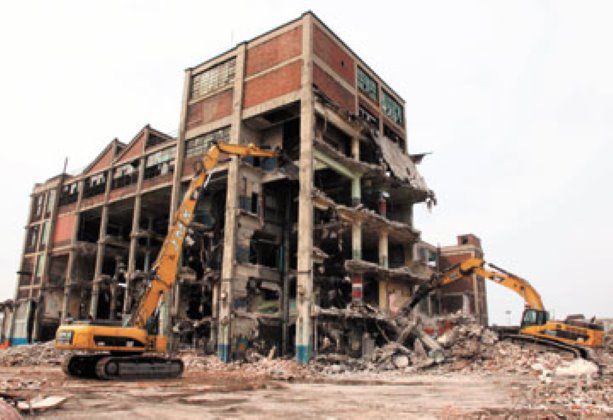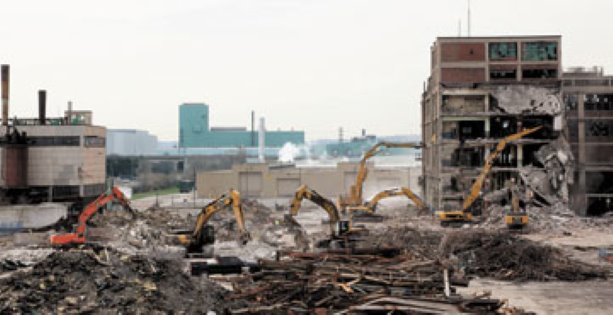A decaying Hamilton, Ontario plant abandoned by Firestone Tire and Rubber Company is currently being demolished by JMX Demolition and Environmental Contractors of Gormley, Ontario.
Typically a man-made lake would be considered an asset to many communities. That wasn’t the case in Hamilton, Ont., where the lake in question was located in the basement of the abandoned Firestone Tire and Rubber Company of Canada plant.
The 250,000-square-foot lake had become a mecca for urban explorers who boasted of plying the lake with rubber dinghies.
■ Daily Commercial News subscribers may view more information on JMX Demolition and Environmental Contractors and its projects by viewing company ID 825901 in Reed Construction Data Canada Building Reports.
If you are not already a subscriber, you can be by filling out the form at this web page.
Building Reports are published daily in the Daily Commercial News. The Daily Top 10 Construction projects can be viewed online free of charge at the Reed Construction Data Canada Building Reports web page.
To learn more about construction project leads from Reed Construction Data, fill out the web form at this web page.
The 40-acre property was originally developed in 1921 by Firestone as a tire manufacturing facility and expanded about a dozen times until 1983. When Firestone closed the plant in 1987, the factory facility covered more than 800,000 square feet. The property was eventually acquired by the city in 2001 and the south portion of the building, comprising about 280,000 square feet, was separated from the plant and renovated to house the Hamilton material recycling facility. The city’s central composting facility sits on the southerly portion of the property.
However, when urban explorers began to publicly encourage others to break into the site, the city found itself exposed to significant liability, forcing it to devote resources to fencing off and policing the site. A tender was issued last year for the demolition of the remaining building, totaling about 552,000 square feet.
“We bid north of $450,000 for the job, with most of our revenue coming from the scrap steel,” says JMX co-owner Jeff Norton. “Finishing the job in an efficient manner is crucial in a contract like this, because the bid price is based on the price of scrap steel and those numbers have been inching down throughout the project. January 2012 marked the 12-month price peak.”
More stories in this feature:
Contractors for Canadian Space Agency to study remediation of low earth orbit
Remediation project at closed Toronto military base includes storm management pond
Tearing down an iconic Sudbury, Ontario tower
Why busted marijuana grow-ops pose a challenge for remediation and demolition
Work began at the start of December 2011 with asbestos and environmental abatement. Demolition began in the third week of January of this year. As part of its demolition arsenal, JMX brought in a dozen workers and eight excavators, including two high-reach models. The remaining excavators included models rated from 15 to 40 tons, equipped with grapples and shears.
Norton says the facility included warehouses, a silo 140 feet tall and a building with a penthouse of about the same height.
“It was in pretty bad shape,” he notes. “The buildings were mostly steel and steel I-beams and rebar encased in concrete, but really badly weathered.”
While most of the buildings were empty, the 120-foot-tall boiler house still contained two large boilers cut up for scrap using an excavator equipped with shears.
“We took down the silo using a controlled drop technique,” says Norton. “We pre-cut the structure at strategic locations then pulled it down with cables.”
All steel and concrete is being processed on site, with the steel removed to recycling facilities on an ongoing basis. Concrete is being crushed and stockpiled on site for potential re-use by the city.
Project challenges include traffic management in consideration of the waste processing facilities still active in close proximity to the demolition site.
“We also gave special consideration to the lake in the basement of the building,” says JMX president John McCrossan. “We were instructed to minimize adding anything to the pool of water. The contract calls for demolition down to the floor slab, with all openings in the slab covered to control further access to the water.”
The Firestone site is built on re-claimed harbour land, so the water ingress problems are related to groundwater seeping in from Lake Ontario and not precipitation, notes Norton. The basement itself is 40 feet deep and filled with 25 feet of water.
“I’ve heard there are even fish in the basement, although how they could live there is a mystery to me,” he says. “While we were working on the project, a former Firestone worker told us that he recalls the company installing more than $3-million worth of tire manufacturing equipment in the basement, and from what we could see, it’s still down there.”
Completion of the project is targeted for May 1st.




Recent Comments
comments for this post are closed